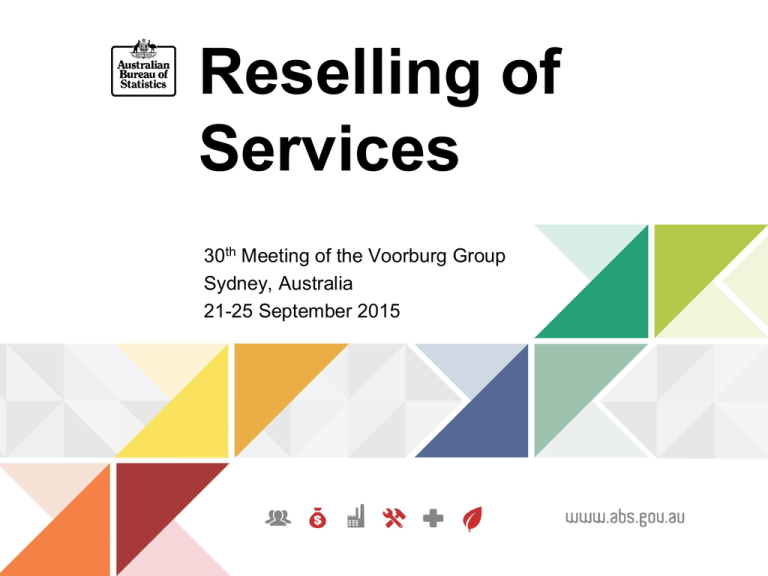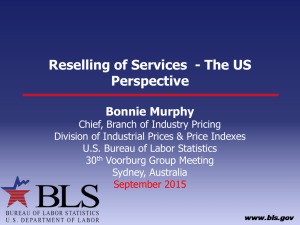Reselling of Services 30 Meeting of the Voorburg Group
advertisement

Reselling of Services 30th Meeting of the Voorburg Group Sydney, Australia 21-25 September 2015 Overview Services in the Australian context What is Reselling? Conceptual and Measurement issues for reselling of services Ownership Industry Classification Practical Application in Turnover Statistics Dive in Surveys Case Studies approach Administrative data Impact on the National Accounts Suggested Best Practice Services in the Australian Context Gross Value Added by Industry, Trend, $ Millions 200000 Agriculture, forestry and fishing (A) ; Mining (B) ; 150000 Manufacturing (C) ; 100000 Electricity, gas, water and waste services (D) ; 50000 Construction (E) ; Total Services Source: ABS, Australian National Accounts: National Income, Expenditure and Product, Jun 2015 (5206.0) Jun-2015 Jun-2013 Jun-2011 Jun-2009 Jun-2007 Jun-2005 Jun-2003 Jun-2001 Jun-1999 Jun-1997 Jun-1995 Jun-1993 Jun-1991 Jun-1989 Jun-1987 Jun-1985 Jun-1983 Jun-1981 Jun-1979 Jun-1977 Jun-1975 0 What is Reselling? An arrangement where the entity buys services from a supplier and resells them to a customer without any significant transformation. Example: Web Hosting Within industries such as Class 5921 - Data Processing, Web Hosting and Electronic Information Storage Services it is common for hosting capacity (i.e. bandwidth) to be bought and on-sold in smaller parcels to retail customers. Without any other transformation we would consider this to be the resale of a service – ie. the distribution in smaller lots is not regarded to be a significant transformation. Once bundling is involved the distinction can become more difficult to determine. Ownership The transfer of ownership rights is a good indication of a reseller arrangement – clearly distinguishes resellers from agents. Purchase or possession of the service by the reseller may not be completed until the final sale to the consumer. But a reseller does have to establish a legally binding liability to acquire or provide the service. Assumes credit risk and inventory risk. Industry Classification ANZSIC 2006 Majority of industries - no separate reseller classes Small number of specific classes for resellers Practical Application – Survey: Information Media and Telecommunications In the Telecommunications Industry, telecommunications resellers commonly purchase network capacity from network providers and resell it via their own channels. In the Information Media and Telecommunications Survey from 2013-14 known issues around bundling and reselling of services were addressed with targeted form design and improved guidelines for respondent businesses. Testing of survey concepts and question wording is necessary to ensure these are well understood, and businesses are able to report the data items intended for capture in the survey. Practical Application – Survey: Information Media and Telecommunications Practical Application – Survey: Information Media and Telecommunications Results Source: ABS, Information Media and Telecommunications Survey, 2013-14 Practical Application: Case Studies Approach Targets sub-industries, issues or requirements of the National Accounts (primarily the Input-Output product data). Case studies investigations are conducted as a follow-up to surveys, to collect finer level detail not able to be captured on a survey form. Applied to industries where: - Output is dominated by a small number of businesses (e.g. passenger airlines) AND/OR; - Industry activity is fairly homogenous, patterns of input and output are relatively consistent Data Collection Method - Personal interviews with business providers - Telephone interviews Advantages of the Case Studies approach - Meets National Account’s needs in a cost effective and timely manner; - Less provider burden than a full survey approach as only a small number of providers are required for enumeration; and - Complex industry concepts discussed in real time through the use of personal interviews. Practical Application: Case Studies Approach Example: Travel Agency and Tour Arrangement Services Case Study Purpose: to collect up to date product information and margins/commissions earned in ANZSIC class 7220. Primary Activities: acting as agents in selling travel, tour and accommodation services as well as businesses providing travel arrangement and reservation services. Also includes businesses arranging, assembling, wholesaling and retailing tours. Participants: Total sample of 18 units classified to Class 7220, across retail (leisure), retail corporate and wholesale. Key Case Study Outputs (to be used as ‘factors’ to update IOPC benchmarks): Estimates for wholesaling activity in domestic package tours, by customer type. Estimates for retail activity in domestic package tours, by customer type. Purchases breakdown of tour components directly sourced from original tourism product suppliers for aggregating and selling as package tours. Practical Application: Administrative Data Business Activity Statement (BAS) is a tax reporting requirement for all registered Australian Businesses. ABS uses this data for: Frame production and unit selections Estimation calibration, imputation and editing strategies. Key Variables: • Turnover, Total Employment, Wages. How can BAS data assist in Turnover Measurement? Data can be used to treat issues around reselling of services through helping to identify which units and industries are likely to exhibit inflated turnover. Quality gate checks of administrative taxation data for turnover per person, and turnover as a proportion of wages. High ratios indicate potential issues with the data, and the presence of margin activity. Example 1: For the Retail and Wholesale Trade industries turnover totals can be up to 20 times the reported value for wages and salaries. Example 2: Information Media and Telecommunications industry has notably higher turnover ratios than comparable services industries. Reflects the myriad of activities that could fall under a reselling services concept e.g. network access wholesaling, licensing, reselling software through hosted platforms (cloud services), etc. National Accounts As primary inputs into the National Accounts, the treatment of reselling of services in turnover and price statistics has a direct impact on the calculation of GDP and industry Input-Output tables. The current approach does not affect the measurement of GDP (as the originally produced service will be deducted from the re-sold service as an input cost), however there is a risk of the output (i.e. total sales) of the industry appearing inflated. Suggested Best Practice Resellers of goods have distinct parallels with resellers of services - they do not consume the goods in any production process and therefore their purchases of inventory are not treated as part of their intermediate consumption. Output should be captured on a margin basis – possibly through the expansion of the Wholesale and Retail trade divisions to include services. Output = Sales – Cost of Goods (or Services) Sold Summary Reselling is emerging as a significant issue in services industries. Reselling of services needs to be treated uniformly and requires further clarification from international guidelines. We recommend capturing the reselling of services on a net or margin basis - through the recording of net receipts in turnover statistics, and through weighting resellers based on marginal revenue in an output price index. As inputs into the National Accounts, the treatment of this issue must be consistent across turnover and price statistics. Contact Information Anthea Guthrie Producer Price Indexes anthea.guthrie@abs.gov.au +61 (02) 6252 7644




